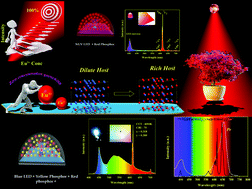Zero-concentration quenching: a novel Eu3+ based red phosphor with non-layered crystal structure for white LEDs and NaSrY(MoO4)3:Sm3+ based deep-red LEDs for plant growth†
Abstract
Oxide based highly efficient narrow band red emitting phosphors are still a bottleneck in white LED applications. Trivalent europium ion based phosphors could be a better choice, however their weak oscillator strength restricts their use in white light emitting diodes (LEDs). Herein, we report a novel red emitting NaSrEu(MoO4)3 (NSEuM) phosphor with zero concentration quenching (non-layered crystal structure). The phosphors (NaSrY1−xEux(MoO4)3, x = 0.1–1, in increments of 0.1) were synthesized through a traditional solid-state reaction and their phase formations were analyzed by powder X-ray diffraction (PXRD) followed by Rietveld refinement. Under 395 nm excitation, all the phosphors showed sharp emission at 616 nm (full width at half maximum, FWHM ∼4–5 nm) owing to the 5D0 → 7F2 electric dipole transition of the Eu3+ ion. A concentration dependent photoluminescence (PL) study revealed that there is no concentration quenching of the systems, leading to them having superior emission characteristics over those of commercial red phosphors as well as a reported Eu3+ phosphor with a layered structure. The color purity of the synthesized phosphor was observed to be 96.32% and it shows excellent thermal stability at 423 K, retaining 64.6% of the emission intensity of its initial room temperature. The NSEuM phosphor shows a high absolute quantum yield of 79.7%. Besides this, a red LED (near UV (NUV) LED chip with the NaSrEu(MoO4)3 phosphor) as well as a hybrid white LED (NUV LED chip with an organic yellow dye + red NSEuM phosphor) were fabricated and their optical properties were studied. After the inclusion of the red phosphor in the hybrid white LED, the color rendering index (CRI)/correlated color temperature (CCT) were improved significantly (60/9333 K vs. 79/6004 K, respectively). In addition, to show the potential use of the system in plant growth application, we systematically investigated the Sm3+ activation in NaSrY(MoO4)3 and found that the phosphor shows orange red emission with an intense deep red emission (645 nm (4G5/2 → 6H9/2)). We fabricated a hybrid red/deep red LED by integrating a NUV LED with a mixed Sm3+ and Eu3+ phosphor and the spectral lines were well matched with the phytochrome (Pr) absorption spectrum. The presently investigated phosphor showed potential in a white LED as well as a deep red/orange-red LED for plant growth.



 Please wait while we load your content...
Please wait while we load your content...